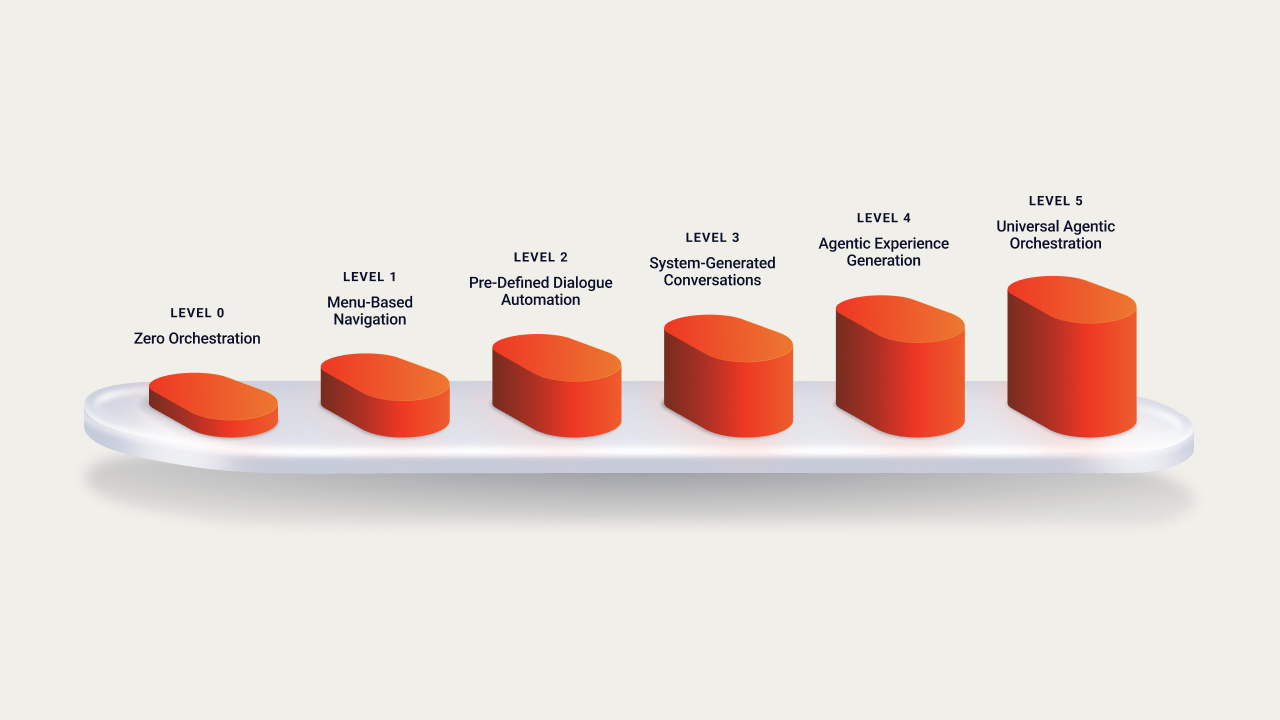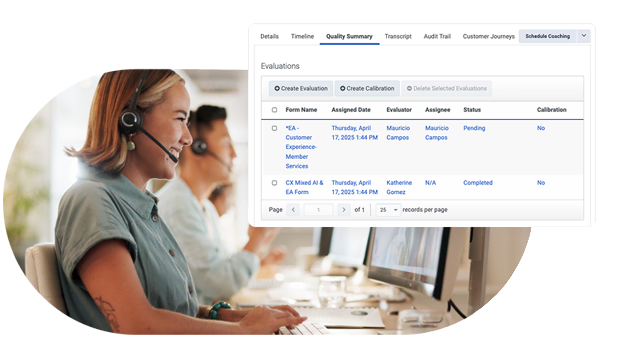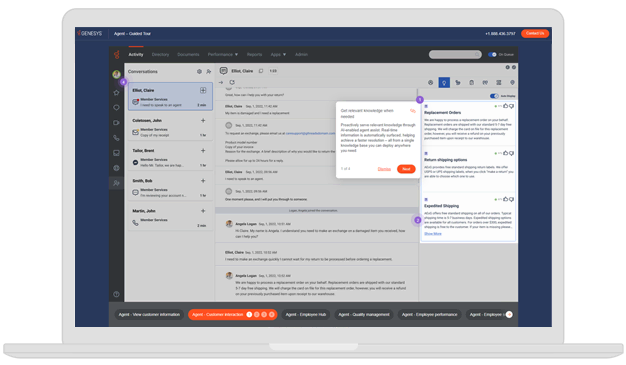Workforce planning guide overview
Master workforce management for modern organizations
This modern workforce planning guide explores how organizations can evolve from spreadsheets to AI-powered workforce management. By applying the Levels of Experience Orchestration, you’ll learn new methods of:
- Defining goals
- Forecasting demand
- Aligning with employee needs
- Applying AI
- Measuring impact
Workforce planning has long been seen as a back-office function — a way to balance schedules, control labor costs and keep operations steady. But in today’s experience economy, it has become a strategic driver of both customer and employee satisfaction.
When employees are empowered with flexible schedules and meaningful work, their engagement increases. And when planners are equipped with data and tools powered by artificial intelligence (AI), they can make more confident decisions that help improve efficiency, reduce attrition and strengthen customer loyalty.
The stakes are high. Research has long shown that replacing a single contact center agent can cost tens of thousands of dollars — not only in recruitment and training, but also in lost productivity and diminished service quality. At the same time, the complexity of managing the modern workforce continues to grow.
Organizations must juggle full-time staff, seasonal workers, gig employees and bots while responding to fluctuating demand. Manual spreadsheets and siloed systems simply can’t keep up.
To help organizations understand and navigate this journey, Genesys developed a maturity model called the Levels of Experience Orchestration. Through its six levels, it defines how businesses can evolve from basic, manual approaches to fully autonomous orchestration of resources and experiences.
Each level represents a meaningful advance in automation, personalization and intelligence. As organizations progress, they move from reactive staffing to proactive, empathetic orchestration that aligns both business and employee needs.
What follows is a closer look at how the Levels of Experience Orchestration apply specifically to workforce planning, beginning with the first steps beyond manual processes and culminating in AI-driven orchestration that continuously adapts to change.

Level 0 — Zero orchestration
Manual processes and disconnected systems
Level 0 represents the starting point for many organizations. Contact center operations rely entirely on manual processes, with no orchestration of data, tasks or systems. Basic telephony systems handle interactions, while human agents depend on static documentation and training — often leading to reactive, inconsistent service.
There is no unified view of the customer journey, no automation to assist with routine tasks, and no system-supported insights. Scheduling, QA and coaching are ad hoc, disconnected and time-consuming. This results in higher agent effort, elevated attrition and a lack of visibility into what’s working or why.
While unsustainable in the experience economy, Level 0 provides the contrast that highlights the value of even basic orchestration. Moving beyond it marks the first step toward operational clarity, employee empowerment and customer-centric transformation.
Level 1 — Menu-based navigation
From spreadsheets to basic forecasting tools
The first step away from manual scheduling is the introduction of basic workforce management tools. At Level 1, organizations move from spreadsheets to simple forecasting and scheduling systems. Planners can generate shift templates that comply with labor laws and account for employee availability. For the first time, the process is systematic rather than purely ad hoc.
This improves consistency and reduces some of the time planners once spent updating spreadsheets by hand. For employees, there is more visibility: Shifts are generated from system rules instead of negotiated line by line. In some cases, employees can see their schedules through an app or portal, which improves transparency compared with paper-based postings.
Why this stage remains reactive
But this stage has clear limitations. Forecasts are still built on historical averages and remain rigid. If demand changes — whether due to seasonality, marketing campaigns or unexpected disruptions — schedules can’t adapt in real time.
Agents might gain visibility into their shifts, but flexibility is minimal. Adjustments still require manual intervention, often at the cost of employee satisfaction or service levels.
From the planner’s perspective, Level 1 reduces some of the chaos but does not eliminate the workload. Compliance is easier and scheduling more orderly, but operations remain reactive.
This stage is a necessary foundation for modernization. By establishing a consistent baseline, organizations prepare themselves to move toward more sophisticated forms of automation that can handle recurring scenarios more efficiently.
Level 2 — Predefined dialog automation
Adding rule-based automation for common tasks
At Level 2, workforce planning adopts rule-based automation. Here, the systems extend beyond static templates to incorporate scripted logic for common scheduling tasks. For example, time-off requests can be automatically approved or declined based on configured rules, while simple shift swaps can be handled without manual review. In effect, the system begins to follow predefined dialogues — much like an early conversational bot does for customers.
For planners, this reduces repetitive work and enables greater accuracy. Forecasts are still largely based on historical data, but they can be validated against actual performance with key performance indicators such as schedule adherence, average handle time or absenteeism. Instead of relying solely on intuition, planners have data they can use to refine decisions.
More flexibility for employees
Employees also experience meaningful gains at this level. Self-service capabilities become available: They can request schedule changes, swap shifts or bid on preferred workplans without waiting on a supervisor. This not only saves time for managers but also increases employee satisfaction by providing flexibility and choice.
The improvements are clear, but so are the constraints. A rule-based system is only as flexible as the scenarios it was designed to handle. If a marketing campaign drives unexpected call volume, or if a strike affects transportation, planners still need to intervene manually to keep staffing aligned with demand. The automation cannot adapt beyond its scripts.
Level 2 is still a transitional stage, but an important one. Organizations reduce the risk of burnout by minimizing repetitive tasks for both planners and agents.
Forecasts and schedules become more accurate, and employees gain greater control over their work-life balance. Yet the planning process remains reactive in the face of disruption.
To overcome this rigidity, organizations must look to more advanced AI capabilities — tools that can generate insights and recommendations dynamically, not just execute rules that have been predefined.
Level 3 — System-generated conversations
Smarter forecasting and real-time visibility

Forecasting accuracy is often improved as planners move beyond simple historical averages to advanced models that test multiple variables and select the most accurate configuration. Ensemble forecasting, anomaly detection and what-if analyses become practical tools rather than aspirational goals.
For planners, this means forecasts are no longer static. They can be generated in seconds, validated against real-time interaction data and adapted for new scenarios as they emerge.
A campaign that draws unexpected call volume, for example, can be modeled instantly, with the system surfacing the staffing adjustments required to maintain service levels. In parallel, intraday monitoring shows whether service levels, adherence and occupancy are aligned with the plan — allowing for swift corrections before small problems cascade into larger ones.
A practical example makes the difference clear. Imagine a retailer preparing for a holiday promotion. The forecast suggested a moderate increase in calls, but actual volume spikes 25% above plan.
At earlier levels, planners would have struggled to react in time, leaving customers waiting and agents overwhelmed. At Level 3, AI detects the deviation in real time, flags the anomaly and recommends specific adjustments such as bringing in part-time workers or redistributing workloads across teams. Managers approve the recommendations and implement them within hours — minimizing disruption, protecting service levels and avoiding costly overtime.
42% of CX leaders surveyed say using AI to improve the customer experience is a strategic priority
“The State of Customer Experience”
Genesys, 2025
Greater transparency for employees and managers
Employees also feel the difference. With self-service mobility apps, they can view schedules, request time off, trade shifts and receive notifications from anywhere.
Transparency increases trust: Agents can see how their preferences are being balanced with business requirements. For managers, copilots surface valuable insights and summarize performance trends in real time, reducing the burden of manual workforce data collection.
The impact on employee experience is significant. By reducing the uncertainty of last-minute changes and enabling flexibility, Level 3 technology helps prevent burnout and attrition. Agents feel more in control of their schedules, while managers spend less time firefighting and more time coaching or planning.
The result is an effective workforce planning process that feels less reactive and more intelligent. Forecasts become both faster and more accurate; scheduling gains flexibility without losing structure. Agents, managers and planners experience greater alignment because the system itself orchestrates a growing share of complexity.
Still, Level 3 is bounded by clear guardrails. AI generates outputs and insights within configured workflows but does not reason independently. Decisions such as approving staffing changes or reallocating resources across functions still depend on human oversight.
For many organizations, this is where they see their first tangible ROI from modern workforce planning, such as reduced overtime, lower attrition rates and improved employee engagement. But this is also the point at which the limitations of rule-bound intelligence become evident. The natural next step is to embrace agentic AI that can plan and act across multiple steps, while still keeping human authority at the center.
Level 4 — Agentic experience generation
Semi-autonomous planning within guardrails
At Level 4, workforce planning takes on a distinctly automated quality. Instead of simply generating recommendations within fixed workflows, the AI now reasons across multiple steps and proposes strategies to achieve defined objectives. Forecasting, scheduling and intraday adjustments no longer operate as isolated functions; they are linked in a continuous, adaptive loop.
Take, for instance, the example of severe weather affecting a business, including its employees and customers alike. At earlier levels, planners would rely on historical patterns and intraday alerts to scramble for coverage.
At Level 4, the AI interprets the situation more holistically: It accounts for the spike in inbound interactions, the availability of reserve staff, the legal constraints on shift lengths and even the relative value of customer segments. It then develops a plan that might blend overtime assignments with targeted use of part-time workers while reallocating experienced agents to high-priority queues.
The difference lies in how the system reasons. Instead of surfacing disconnected recommendations, it generates a coordinated strategy, evaluates trade-offs and presents a clear path forward. Yet the AI doesn’t act entirely on its own.
Guardrails are defined by the business: which decisions can be automated outright, which require supervisor approval and which must remain in human hands. This balance helps ensure transparency, prevents overreach and builds trust between employees and the system.
Predictive routing becomes another powerful tool at this stage. By analyzing customer and agent data in real time, the system dynamically matches interactions to the employee most likely to achieve a positive outcome.
This improves efficiency and customer satisfaction simultaneously, while also feeding back valuable data into workforce planning models. When combined with proactive intraday monitoring, it allows the system to anticipate bottlenecks and recommend adjustments before service levels are compromised.
Empathetic orchestration for employees and customers
For employees, the leap to Level 4 is palpable. Copilots evolve from passive assistants to proactive guides, surfacing contextual nudges during interactions.
An agent might receive a subtle reminder to verify compliance language, a suggestion to use a particular knowledge article or even a prompt to trade a shift or join a quick training session if interaction volume is low. Supervisors, meanwhile, could be prompted to schedule coaching when error patterns emerge or to adjust staffing before fatigue becomes evident.
Schedules, too, reflect a new quality of empathy. Instead of being optimized solely for coverage, they are shaped by employee preferences, career goals and well-being indicators. The AI might suggest rotating unpopular shifts more equitably, or flag when an agent’s workload risks leading to burnout.
Gamification features can be layered in, setting achievable goals and rewarding performance in ways that motivate without creating undue pressure. Employees begin to see workforce planning and performance management as functions that support their success — and amplify their specific skills — rather than constraining them.

Studies have shown that replacing a single contact center agent can cost $10,000–$20,000 — a figure that quickly multiplies when turnover is high. By preventing even a fraction of this attrition, Level 4 workforce planning can deliver substantial ROI alongside operational benefits. substantial ROI alongside operational benefits.
For customers, the impact is equally significant. Interactions feel more anticipatory and less transactional. A frequent traveler facing a disruption may be offered an upgrade automatically; a banking client might receive proactive outreach before a payment issue escalates.
Customers sense that the organization not only understands their immediate needs but is actively working to safeguard the broader relationship. This is where empathy begins to permeate service at scale, reinforcing loyalty in ways that manual processes cannot replicate.
Level 4, then, represents a turning point. The AI does not simply assist; it collaborates, planning alongside humans within guardrails that preserve trust. Employees experience greater support, customers feel better understood and organizations benefit from efficiency gains that are both operational and relational. The groundwork is now firmly laid for Level 5, where orchestration becomes continuous, distributed and fully autonomous.
Level 5 — Universal agentic orchestration
Fully autonomous capacity planning and adaptation
Level 5 represents the culmination of the Levels of Experience Orchestration framework: universal agentic orchestration. At this stage, workforce planning is not a collection of discrete tasks but a living, adaptive system. AI agents collaborate continuously across HR, operations and customer service, managing complexity at a scale that humans alone could never sustain.
Capacity planning becomes predictive and self-correcting. Instead of manually updating spreadsheets or running static reports, the AI ingests unified data from every part of the organization — forecasts, schedules, performance metrics, attrition patterns and shrinkage rates — to project staffing needs months, or even years, in advance. This foresight allows HR leaders to work backward from known peaks, planning when to recruit, onboard and train new employees so they are fully proficient at the exact moment demand arrives.
Scenario modeling is central here. The system can simulate multiple futures — a seasonal surge, a new product launch, a labor strike — and prepare alternative staffing strategies for each. Leaders no longer ask, “What happens if volume increases by 20%?”
Instead, they see how the AI has already modeled the scenario, adjusted the plan and flagged when additional approvals are needed. Strategic questions become less about whether the business can handle demand, and more about which growth opportunities to pursue.
The orchestration doesn’t stop at long-term planning. In real time, the orchestration engine efficiently distributes workloads across virtual agents, human agents, queues and channels.
If unexpected absenteeism threatens service levels, the system reroutes digital interactions to available staff, deploys bots to absorb routine work or even creates new virtual agents to fill the gaps — all without manual intervention. The orchestration logic adapts fluidly, driven by objectives defined at the leadership level.
Seamless, frictionless customer experiences

Employees, too, experience unprecedented support. Shift swaps, time-off approvals and workload adjustments are handled automatically within mobile apps, creating schedules that feel both personalized and fair. Training is no longer reactive but planned months in advance, with modules aligned to anticipated campaign needs or seasonal surges. AI-powered nudges still provide real-time coaching, but they are integrated into a broader development path that employees can see and influence. The result is lower attrition, higher satisfaction and stronger alignment between employee goals and business growth.
For customers, the experience is seamless. When disruption strikes — a severe storm, a supply chain issue, a product defect — updates, rebookings and communications happen proactively across channels. Customers don’t need to wait in queues or repeat information. Instead, they are met with solutions already in motion, tailored to their history, preferences and situation. Service feels frictionless and emotionally intelligent, as though the organization anticipates needs before they are expressed.
Theoretically speaking, once a business reaches Level 5, the outcomes are profound. Attrition costs are reduced through empathetic scheduling and proactive support. Forecast accuracy can rise above 95%, minimizing overstaffing and overtime spend. Customer satisfaction improves because wait times stabilize even during volatile events. And leadership gains confidence that the workforce is not just reacting to the present but prepared for the future.
However, only a minority of organizations are even ready to consider setting their sights on this level today. According to “The State of Customer Experience” report, just 16% of customer experience (CX) leaders say they have fully integrated systems capable of enabling channel-less journeys — and even fewer have adopted the agentic AI required for achieving the previous stage, Level 4.
But the potential of Level 5 at least makes the direction of travel clear. As more enterprises embrace unified data models, embedded AI and cross-functional orchestration, the ability to operate at Level 5 will become a defining marker of competitive strength.
Universal agentic orchestration is not simply a vision of automation. It is a model of resilience, adaptability and empathy — qualities that define success in the experience economy. For organizations that invest in this journey, the reward is more than operational efficiency. It is the ability to deliver human-centered service at scale, helping create loyalty that endures disruption and differentiation that lasts in crowded markets.
65% of CX leaders say they already use AI to streamline the customer journey across channels
“Customer experience in the age of AI”
Genesys, 2024
From strategic planning to real ROI
The progression through the Levels of Experience Orchestration shows how workforce planning can evolve — by implementing new technologies — from manual scheduling into a strategic capability that continuously adapts to change. Each level introduces novel advances that build upon the last: from basic consistency in Level 1 to rule-based automation in Level 2, generative insights in Level 3, agentic reasoning in Level 4 and finally, fully autonomous orchestration in Level 5.
For planners, the gains are clear. Manual spreadsheets give way to automated forecasts, then to AI systems that anticipate disruption, rebalance workloads and even model long-term staffing needs months in advance. The role shifts from clerical to strategic: instead of patching holes in schedules, leaders can focus on shaping policy, guiding employee development and aligning the workforce with business goals.
For employees, the journey is just as transformative. Early levels provide basic visibility into shifts; later ones empower self-service and flexibility. By Level 4, schedules are empathetic, anticipating well-being alongside productivity.
At Level 5, administrative burdens are minimized, leaving space for meaningful engagement. This progression can directly reduce attrition, improve satisfaction and strengthen the connection between employees and the brand.
And for customers, the impact is unmistakable. Service evolves from reactive and transactional to proactive and emotionally intelligent. Wait times fall, continuity improves and interactions feel more human, even as AI carries more of the load.
The ROI is tangible. Organizations that move up the maturity curve can see overtime costs fall as scheduling becomes more accurate, attrition costs shrink as employees stay longer and forecasting accuracy climbs. Each of these outcomes translates directly into measurable savings and competitive advantage.
It’s important to note that maturity is not a strict linear path. Many organizations operate across multiple levels at once, using deterministic automation for certain functions while piloting agentic AI for others. What matters is a deliberate commitment to moving forward.
As you evaluate your own approach to workforce planning, consider not just where you are today but what advancing further could mean in concrete terms: reduced costs, lower attrition, greater resilience and measurable impact. In the experience economy, progress through the Levels of Experience Orchestration is more than optimization — it’s the path to stronger relationships, smarter decisions and lasting competitive advantage for your brand.








